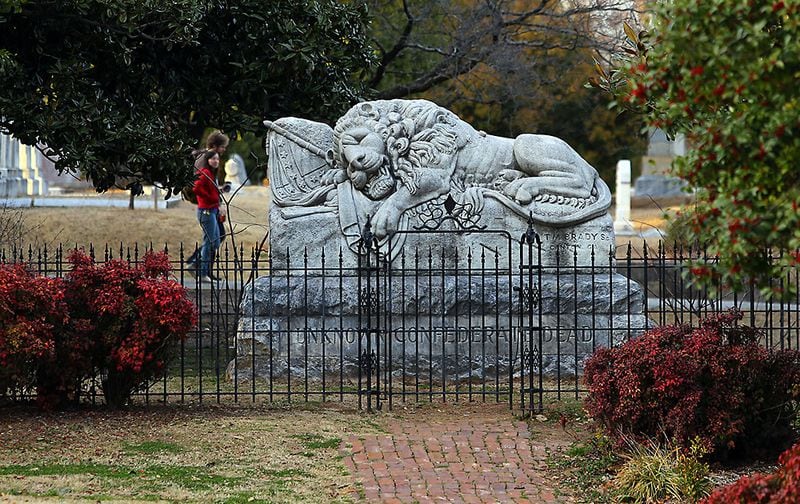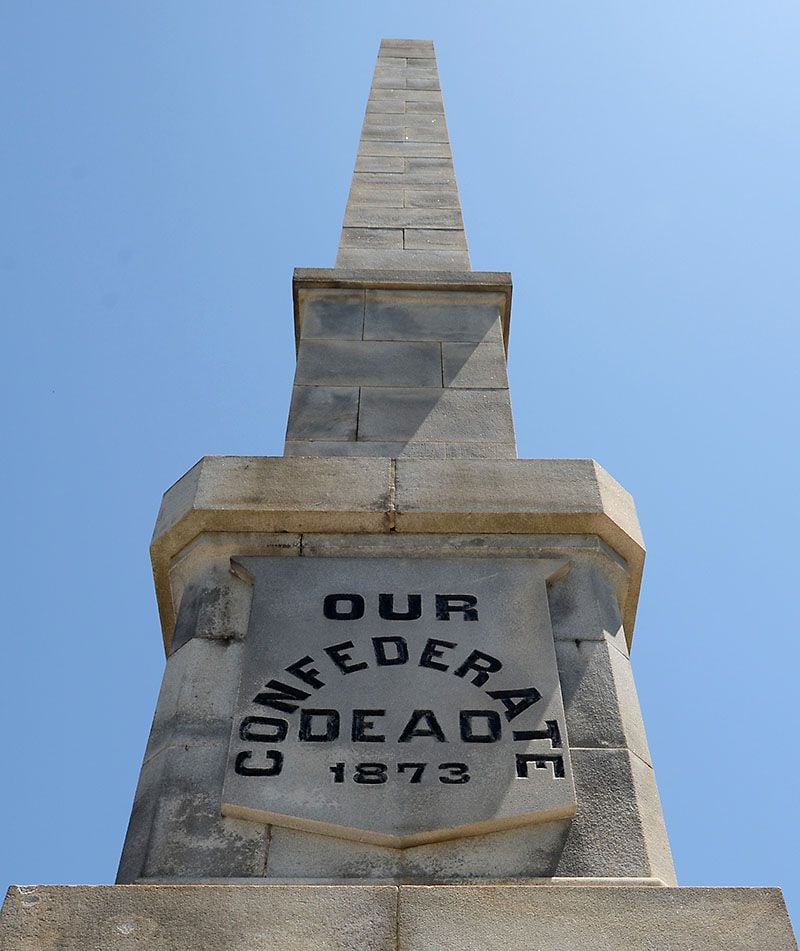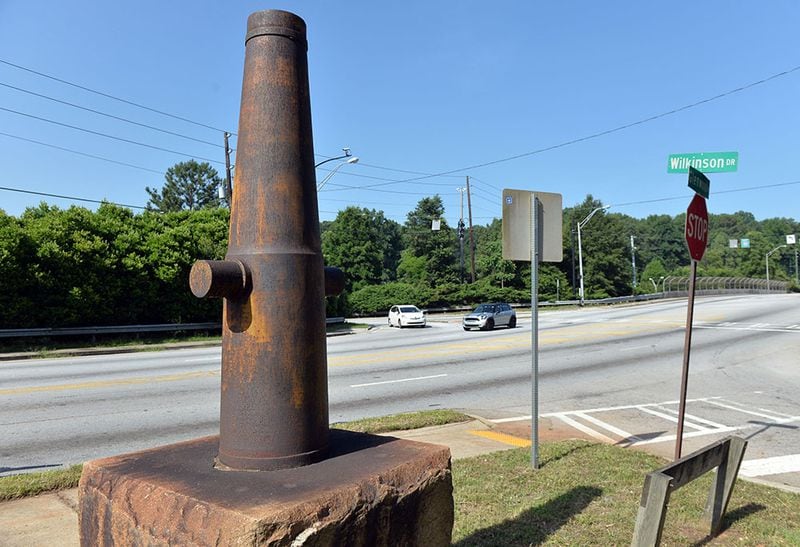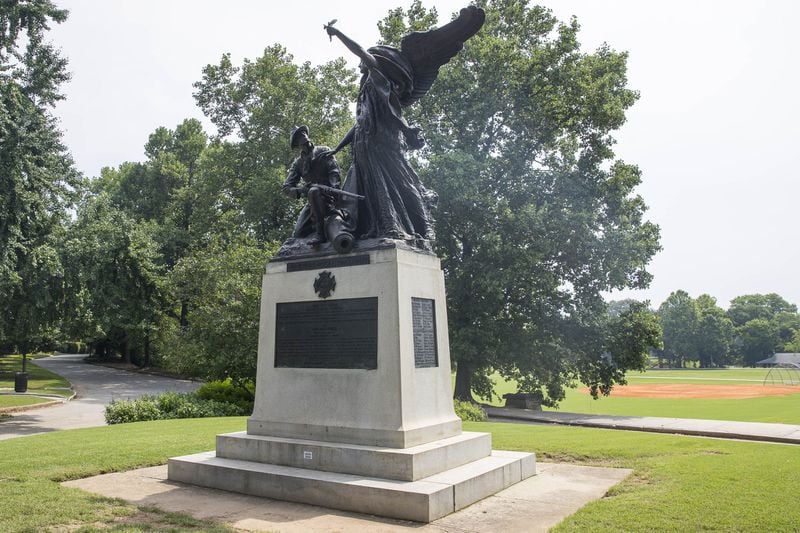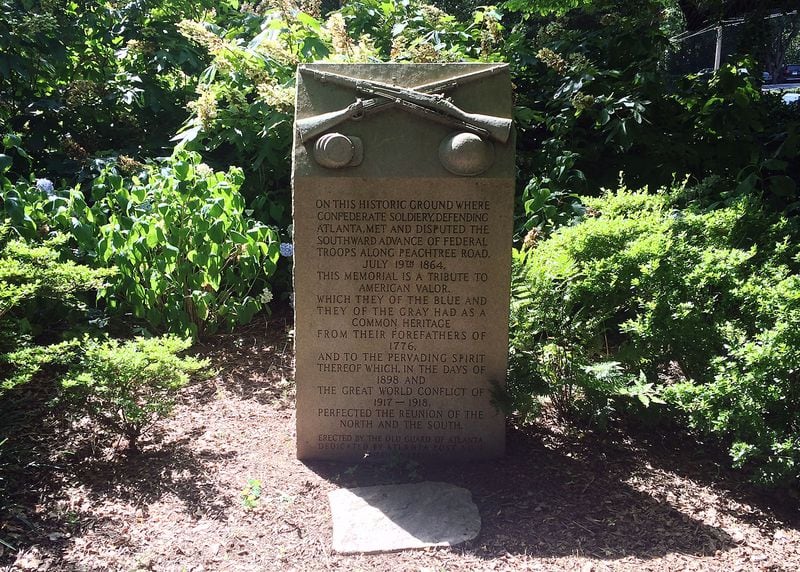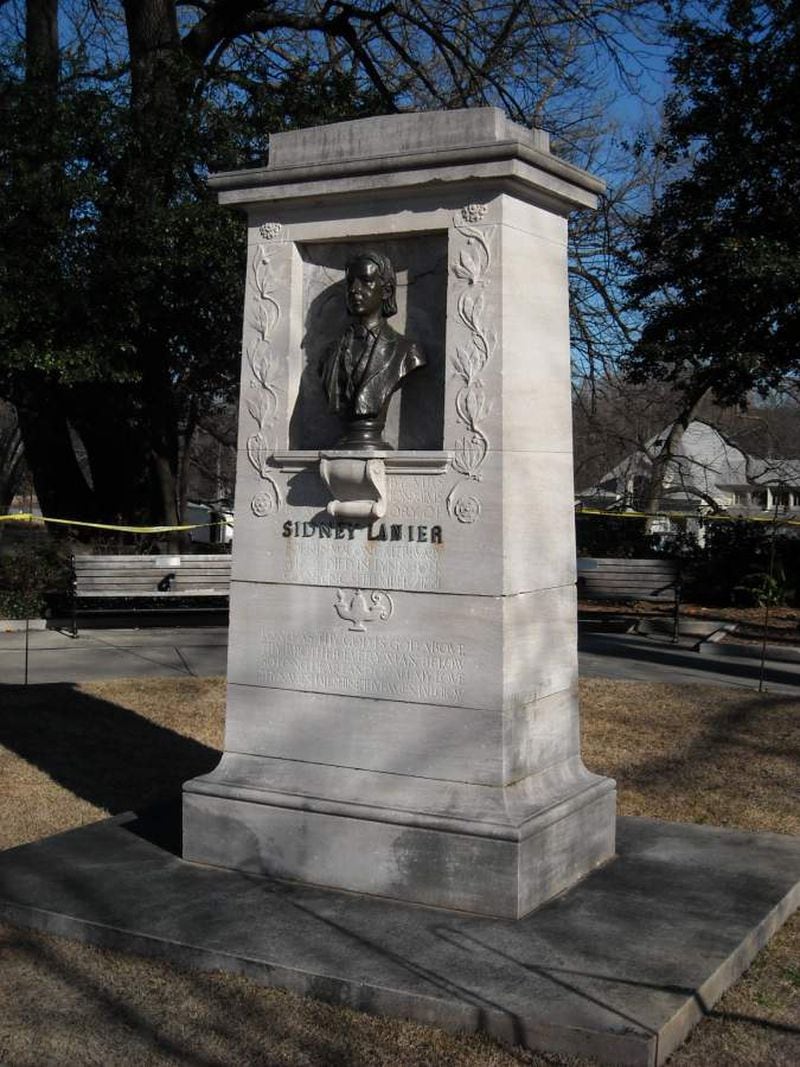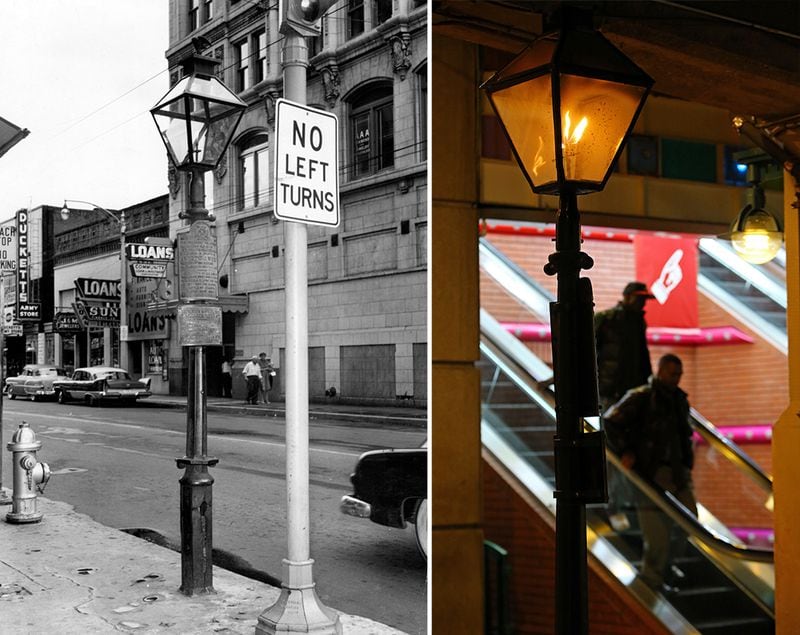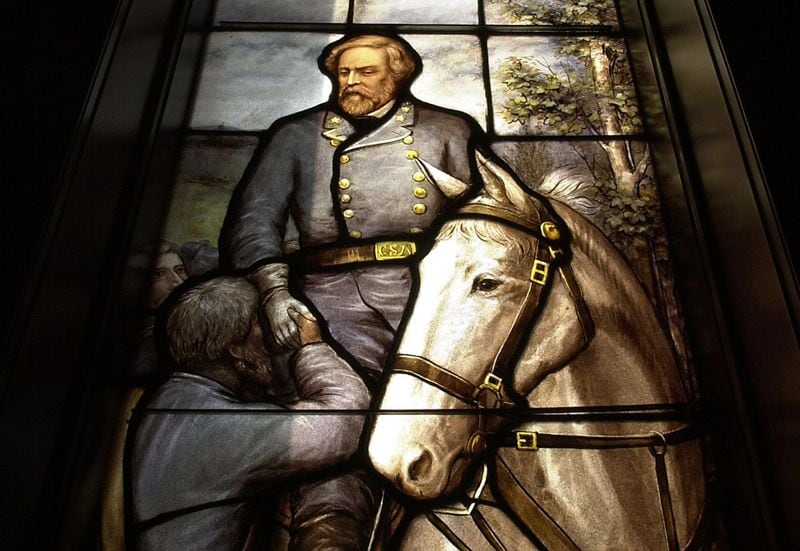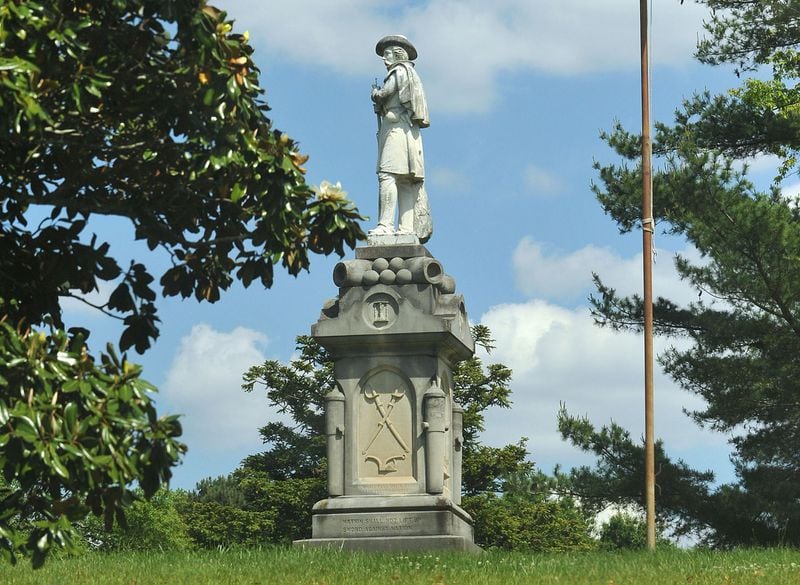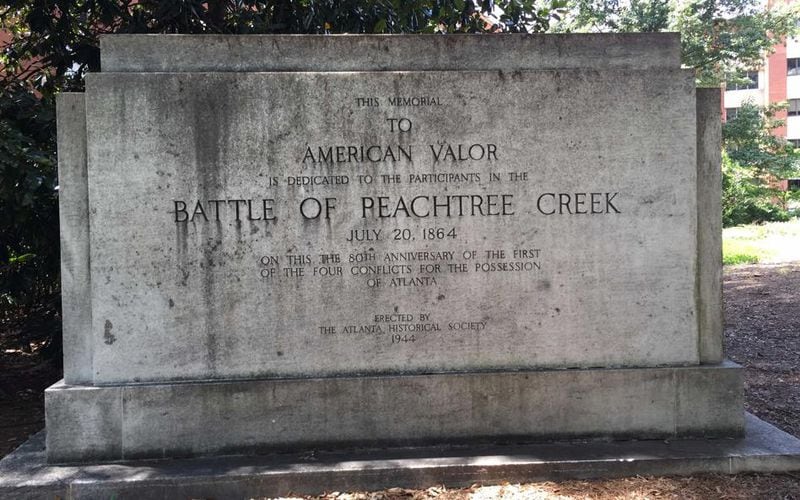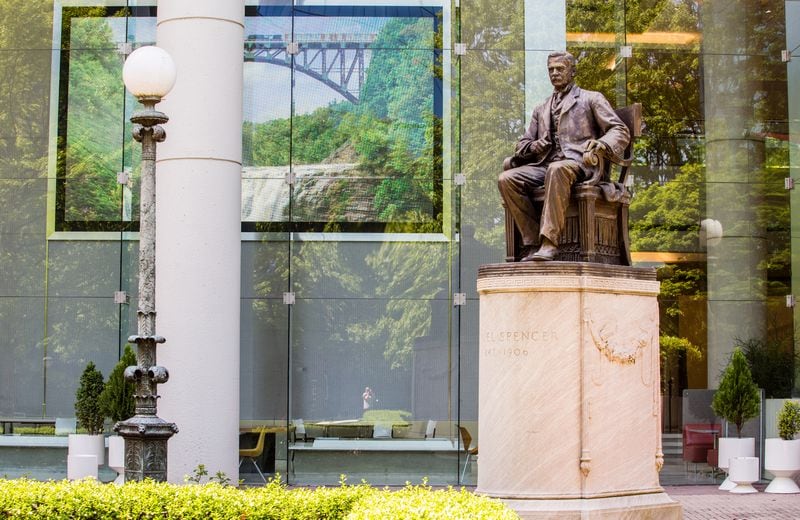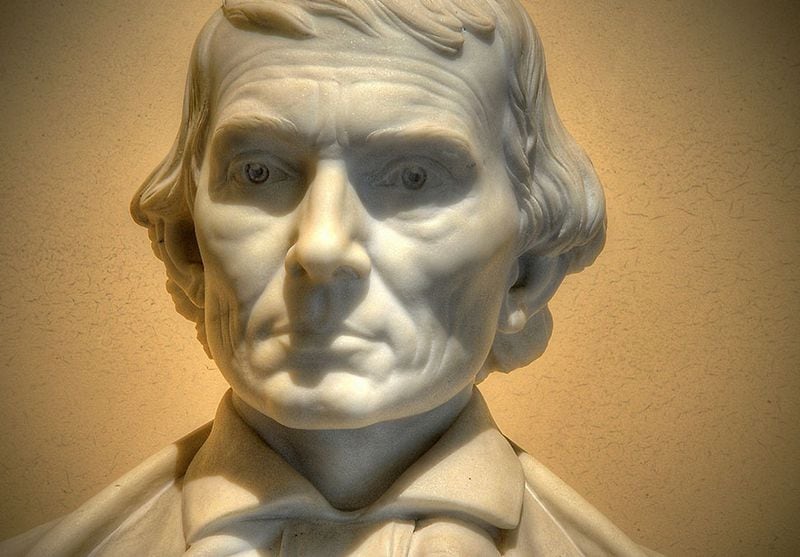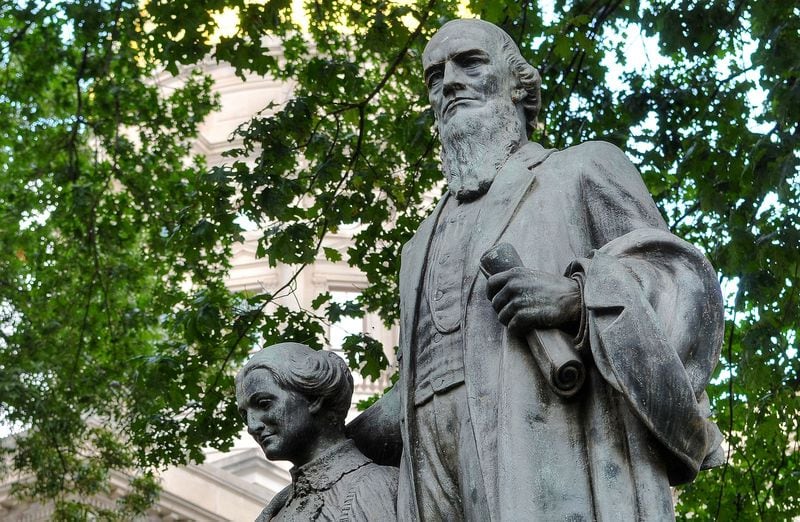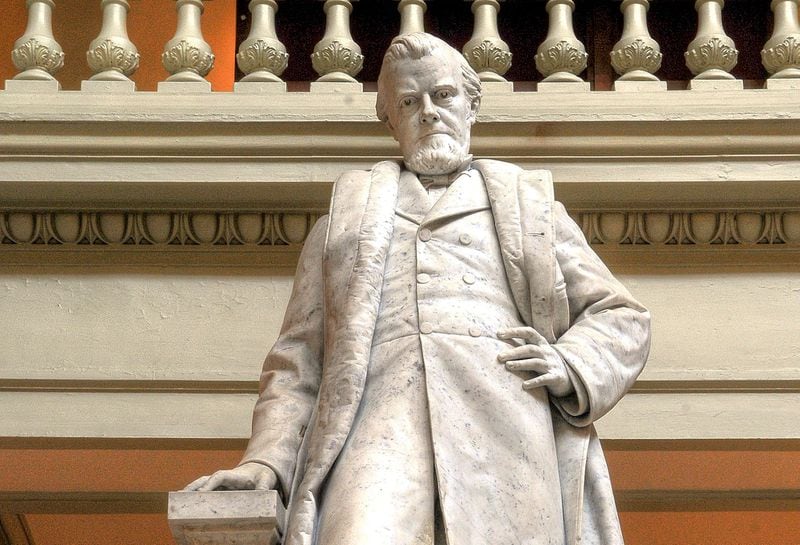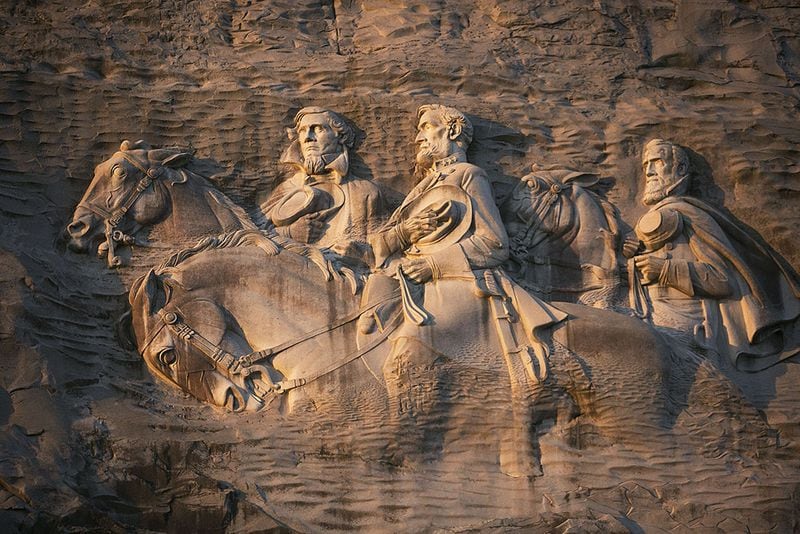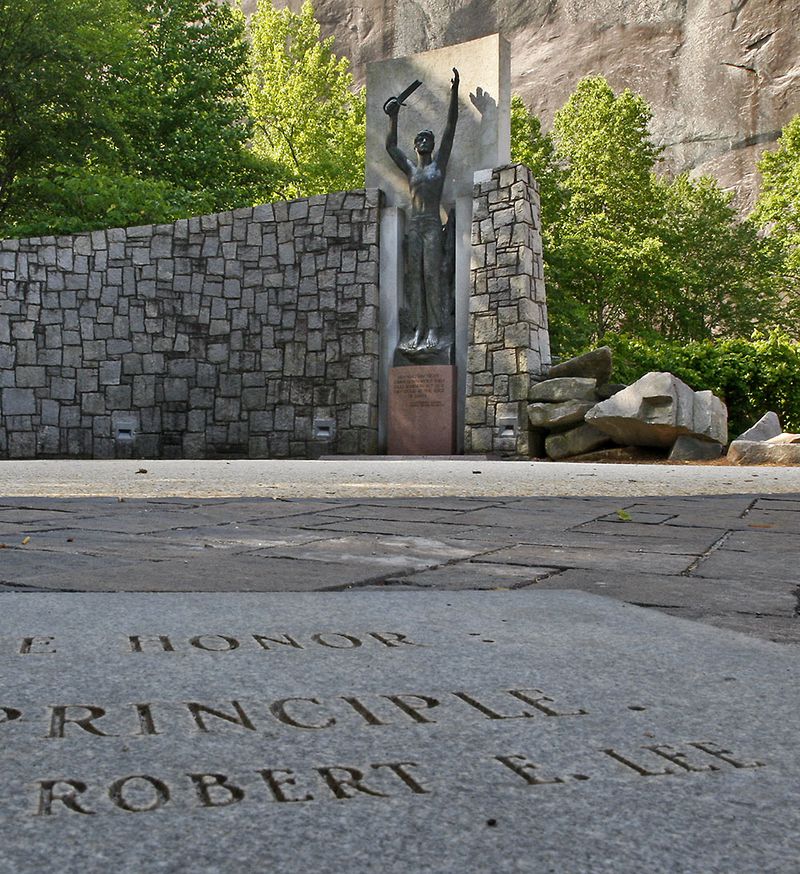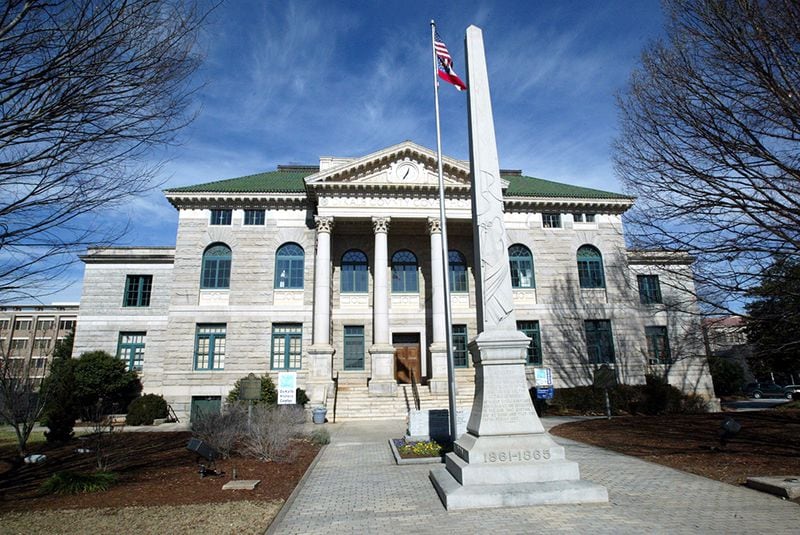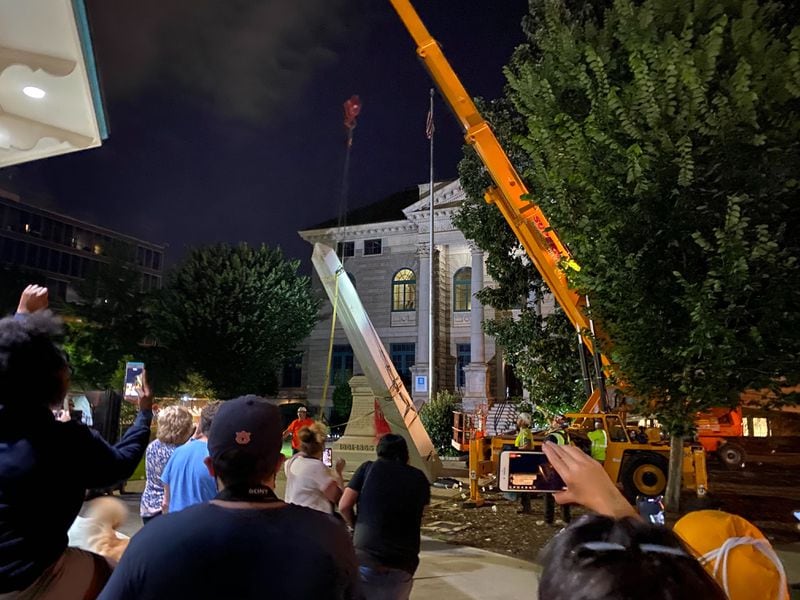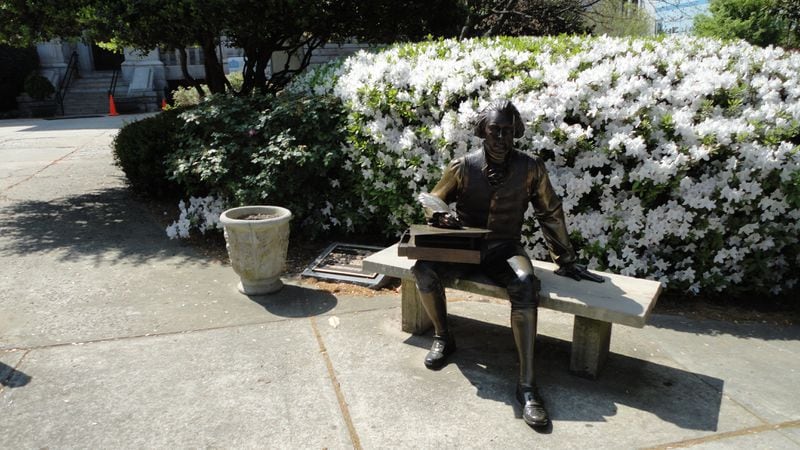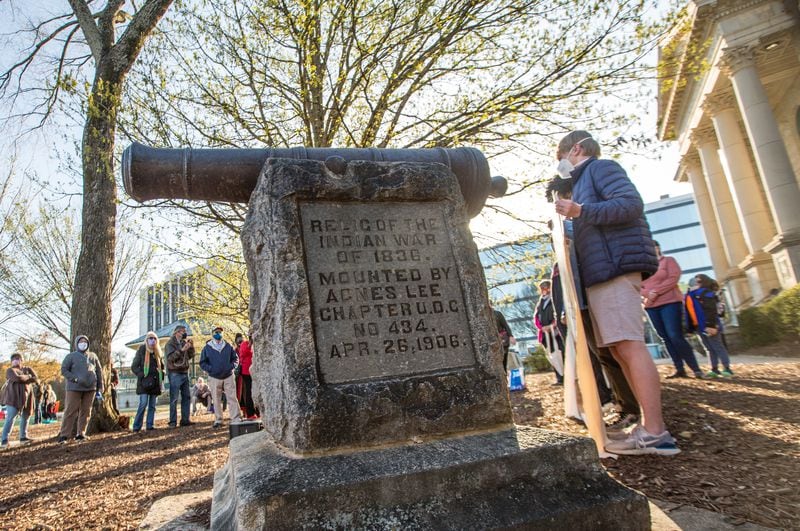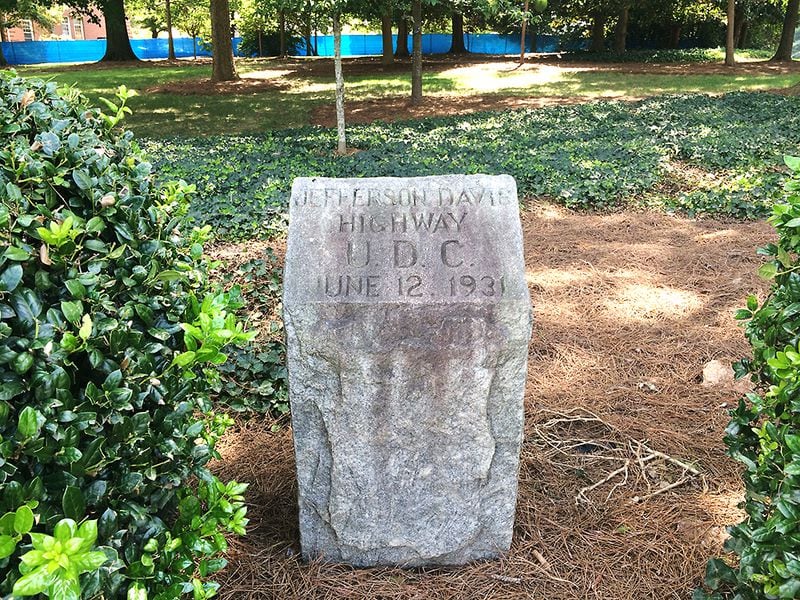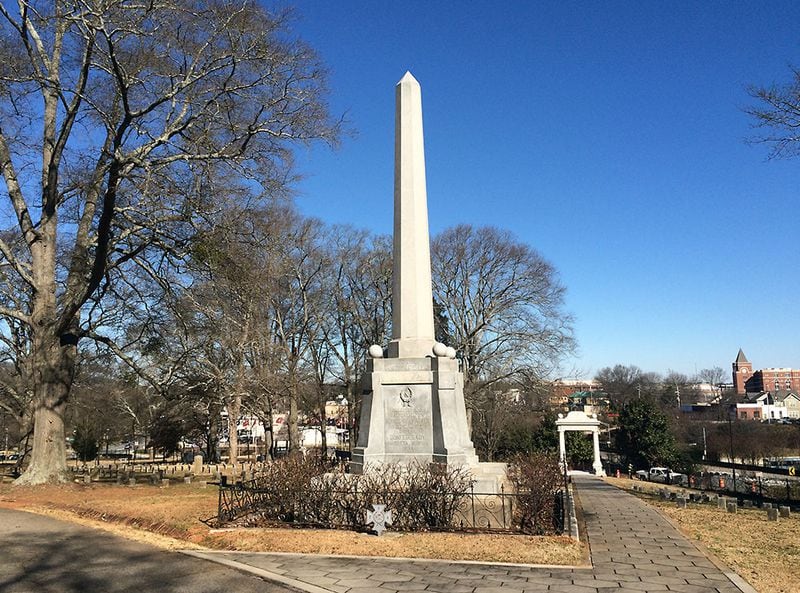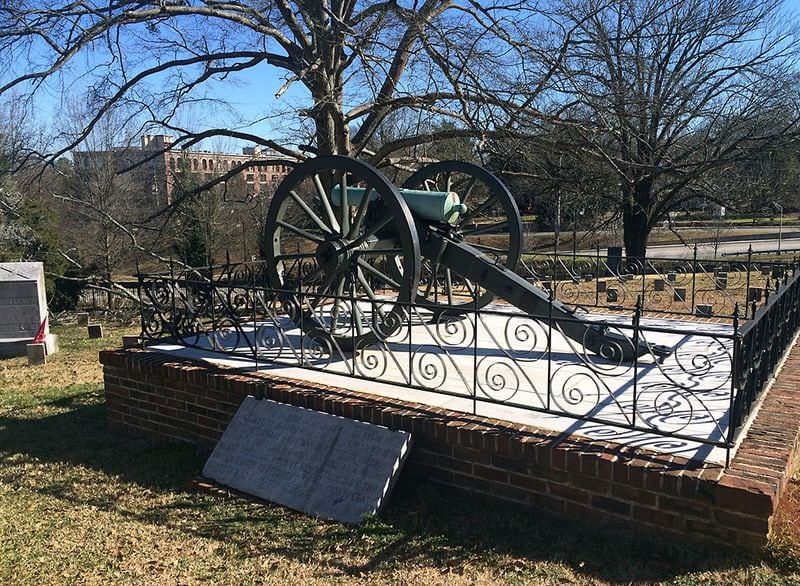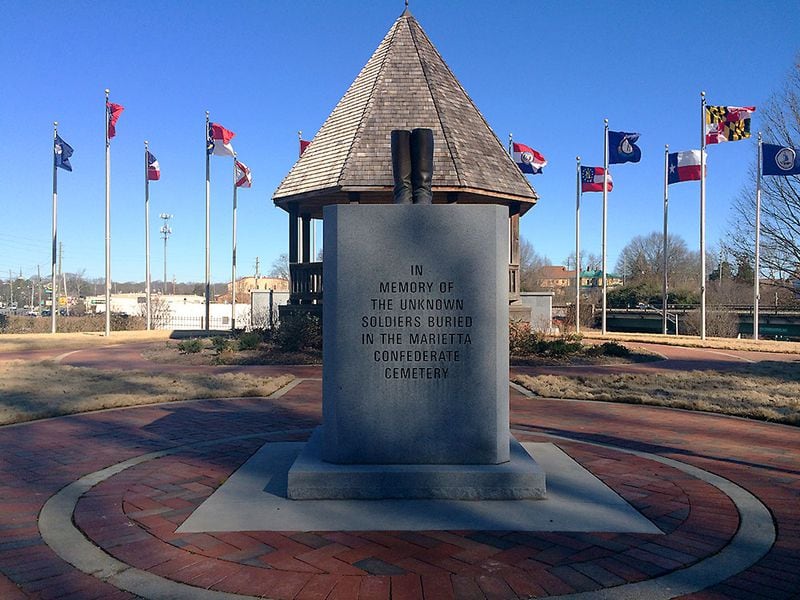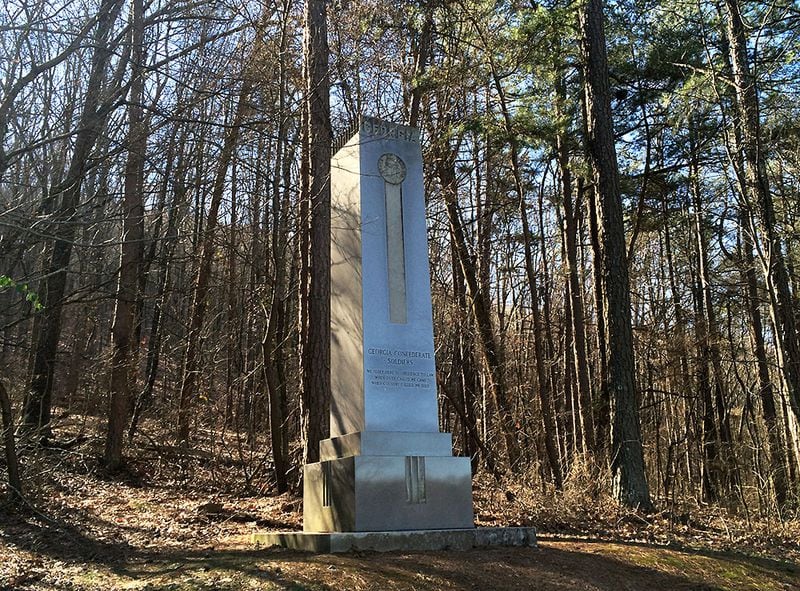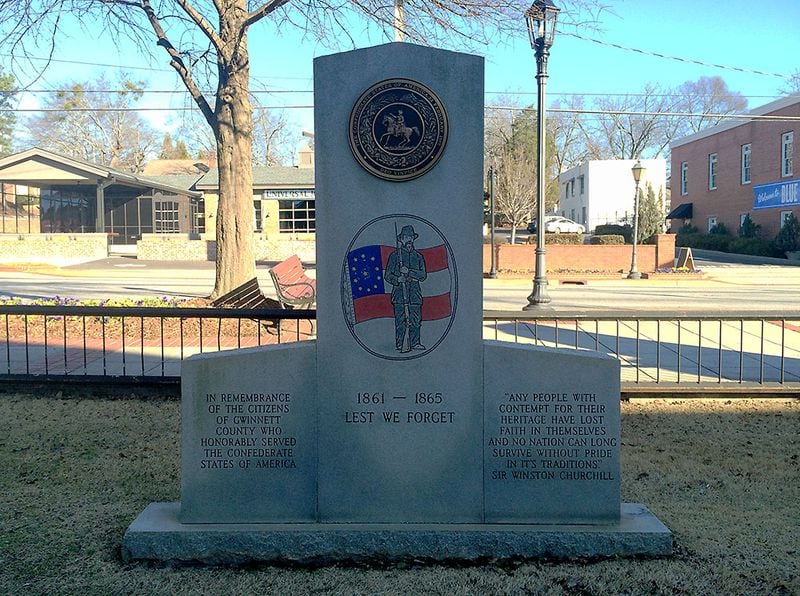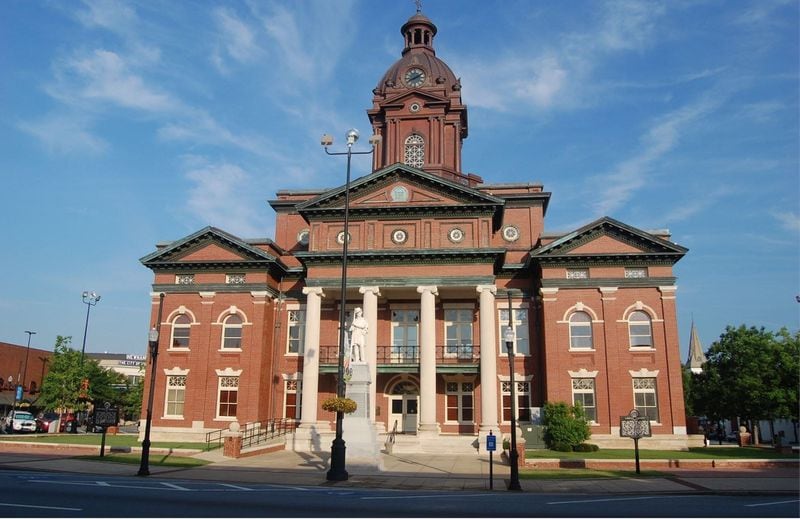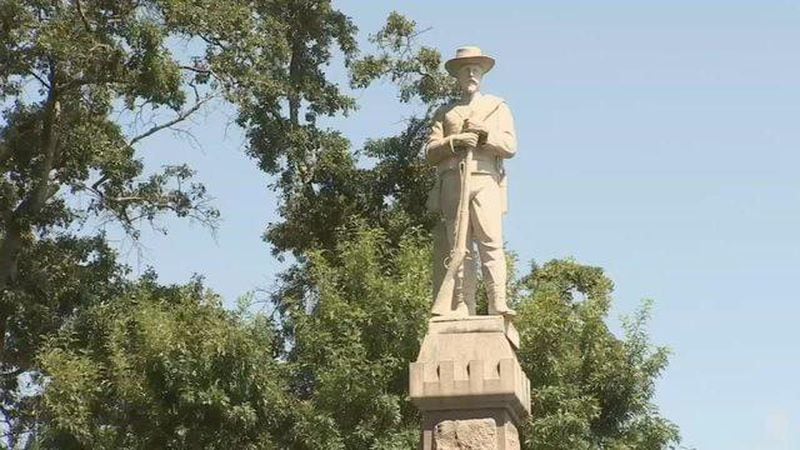UPDATED Oct. 26, 2023: In the wake of recent protests against racism, monuments to the Confederacy around the country are coming down, sometimes by local governments and other times by the protesters themselves.
In 2019, Georgia passed a law that prohibits anyone, including local officials, from removing, defacing or changing Confederate monuments. Soon after, some local governments erected contextual markers next to monuments, such as the Decatur Square obelisk and Atlanta's Peace Monument in Piedmont Park (see below).
In Atlanta, the city created an advisory committee to determine what to do with four monuments on city property. That 2017 effort produced several new contextual markers and the renaming of Confederate Avenue to United Avenue in 2018.
Protests over the monuments have only grown in intensity since then. In 2019, two monuments were removed by local officials — in Decatur and Kennesaw — despite the state law. Funerary monuments in Oakland Cemetery were vandalized overnight. At the Capitol, protesters chanting “Tear down Gordon” faced off with guards over the equestrian statue of John Brown Gordon.
Here are the most visible places in metro Atlanta that commemorate the Confederacy and its leaders. (And for more information about Confederate and segregation-era politicians honored at the Capitol, click here.)
Credit: Curtis Compton
Credit: Curtis Compton
LION OF THE CONFEDERACY (REMOVED from Oakland Cemetery)
For a city that saw so much Civil War fighting, the city of Atlanta has remarkably few large displays memorializing the Confederacy. The two largest can be found in historic Oakland Cemetery. This monument, based on Switzerland's Lion of Lucerne, is surrounded by the graves of 3,000 unknown Confederate soldiers. It was constructed in 1895 by the Atlanta Ladies Memorial Association and is on a Smithsonian list of significant funerary art.
In 2019, the city erected a new marker after its advisory committee recommended that iconography within Oakland Cemetery be left in place with added context.
However, on four occasions in May and June 2020, vandals covered the sculpture with spray-paint graffiti. Other parts of the cemetery were damaged too — the Confederate Obelisk, Confederate tombstones and one of the new contextual historical markers.
As for the Lion, the City Council voted in August 2021 to remove the monument and place it in temporary storage, but did not specificy a permanent placement.
Credit: Chris Hunt
Credit: Chris Hunt
THE CONFEDERATE OBELISK (Oakland Cemetery)
Made from Stone Mountain granite, this obelisk anchoring the Confederate section of Oakland Cemetery is the tallest object in Oakland Cemetery. It was erected in 1873 by the the Atlanta Ladies Memorial Association.
The Confederate section of Oakland holds 6,900 soldiers, some who died during battles fought along Sherman's campaign towards the city, and some from other battles who found themselves treated at Atlanta military hospitals.
As with the Lion of the Confederacy, the Atlanta committee recommended to leave this monument in place with added context, and to remove the Confederate flag flying next to it.
It was covered with spray paint during the nights of vandalism in May and June 2020.
W.H.T. WALKER MEMORIAL (Glenwood Avenue)
Confederate Gen. W.H.T. Walker is memorialized in the spot where he was shot dead by a Union sniper, at today's intersection of Wilkinson Drive and Glenwood Avenue. About half a mile away at Monument and McPherson Avenues, a similar monument marks the spot where Union General John B. McPherson was killed by Confederate forces the same day.
In its published report, the Atlanta committee concluded that the Walker memorial was "a battlefield marker and does not serve a purpose of glorification." The committee recommended adding context to both the Walker and McPherson memorials.
PEACE MONUMENT (Piedmont Park)
The large monument greeting park visitors at 14th Street depicts a Confederate soldier with an angel calling a halt to his fighting. The monument was built in 1911 by former members of the Gate City Guard—a Confederate-era city militia—that was on a peace mission to unite the North and South in the decades after the Civil War. Today's Old Guard of the Gate City Guard still rededicates the monument each year.
In 2017, the Atlanta committee report concluded that it represented "Lost Cause mythology" and recommended its removal. Earlier that year, protesters defaced the monument with paint in two separate incidents and tried to topple it.
A contextual marker was added to the monument in 2019 but its language also created some controversy.
In June 2020, the words "No Peace" were spray-painted on the monument.
Credit: Pete Corson
Credit: Pete Corson
PEACHTREE BATTLE AVENUE MONUMENT (Peachtree Battle Avenue)
The Old Guard of the Gate City Guard is behind this monument too, erected in 1935. Like the Peace Monument, its carved message stresses reconciliation between the North and South. The Atlanta committee concluded that the monument "falsely depicts the character of post-Civil War reconciliation by reflecting Lost Cause mythology" and recommended that it be removed.
Instead, the city erected a contextual marker next to it in 2019.
SIDNEY LANIER BUST (Piedmont Park)
This statue was erected by the Piedmont Park Association in 1914. Lanier was a famous musician, poet and author from Macon who was inducted as a charter member of the Georgia Writers Hall of Fame. His artistic legacy is so large that Lanier County and Lake Lanier are named after him.
In his youth, Lanier was a Confederate soldier who was captured by Union forces. He contracted tuberculosis while a prisoner of war and this condition would plague him until his death. Lanier's only published novel was a good-vs-evil tale with a Yankee villian.
In 2012, the bust was relocated to Oglethorpe University and a replica was installed at Piedmont Park. The Atlanta committee concluded that the bust was not a Confederate monument and recommended leaving it in place.
ATLANTA STREET NAMES
The Atlanta committee report identified 34 city streets possibly memorializing the Confederacy and recommended that some names get changed immediately: Confederate Avenue, East Confederate Avenue, and any street named after Nathan Bedford Forrest, John B. Gordon, Robert E. Lee, Stephen Dill Lee, or Howell Cobb.
Only Confederate Avenue and East Confederate Avenue were renamed as a result, officially becoming "United Avenue" in 2019.
Up the road, the Sandy Springs city council wants to change the names of two roads that possibly honor Confederate Gen. Nathan Bedford Forrest. The streets — Forrest Lake Drive and Lake Forrest Drive — would have an "r" removed in each case to make the names more sylvan. (Not every resident believes that the streets were named after the notorious general.) Both roads stretch into the city of Atlanta, which would also have to approve the change for those parts of the roads.
Private spaces
The following monuments are on private, not public grounds:
Credit: AJC file
Credit: AJC file
ETERNAL FLAME OF THE CONFEDERACY (REMOVED from Underground Atlanta)
This gas lamp was one of 50 original Atlanta Gas Light Co. lamps first lit on Christmas Day, 1855. It stood on the northeast corner of Alabama and Whitehall (now Peachtree) Streets, right next to where Solomon Luckie stood when he was struck by a shell during the Siege of Atlanta in 1864. (The photo on the left, from 1957, also shows where the shell blast damaged the front bottom of the lamppost.)
According to Atlanta Time Machine, the lamp was displayed in City Hall from 1864-1880 as a war memento and wound up being returned in 1919 to its street corner. During the 1939 'Gone With the Wind' premiere, the Old Guard Battalion of the Gate City Guard lit the lamp and declared it 'The Eternal Flame of the Confederacy.'
The creation of the viaduct and Underground Atlanta muddle the history of the lamp's location a bit — at one point it stood above ground. Then it was moved below to Underground Atlanta at roughly the same location, right outside a set of public restrooms.
Underground Atlanta is now closed to the public as it undergoes an extensive redevelopment. In 2017, the City Council donated the lamppost to the Atlanta History Center, where it is now a part of its exhibition “Cyclorama: The Big Picture.”
Credit: Charlotte B. Teagle / AJC file
Credit: Charlotte B. Teagle / AJC file
THE RISE AND FALL OF THE CONFEDERACY (Rhodes Hall)
Not all memorials are built of stone or metal. This granite mansion in Midtown has a series of stained glass windows that show the history of the Confederacy, including key battles and portraits of generals and statesmen. The windows were reinstalled at the home in 1990 after spending 25 years in storage at the Georgia Archives. Rhodes Hall hasn't been a public space since the Georgia Trust took possession of it in 1983, but it spent decades as a state building — the home of the Georgia Archives from 1930-65.
Credit: KENT D. JOHNSON / AJC
Credit: KENT D. JOHNSON / AJC
WESTVIEW CEMETERY MEMORIAL
First thing to know — this cemetery, founded in 1884, is private, and still has more than 200 burials a year. (Not a good place for a picnic or jog, in other words.)
That also means that this memorial was not part of Atlanta’s advisory committee report, which only applied to city-owned property.
The cemetery sits where the Battle of Ezra Church was fought during the Campaign for Atlanta. This memorial was erected by the Confederate Veterans Association of Fulton County in the Confederate section of the cemetery. It's ringed by soldiers' graves and has a pair of small cannons guarding it. Nearby Mozley Park, where Ezra Church stood, contains more historical markers commemorating the battle.
Several years ago, the cemetery removed a Confederate battle flag near the statue after discussing the matter with the Sons of Confederate Veterans.
Although Westview has not experienced the level of vandalism that Oakland Cemetery has seen in recent weeks, another part of Westview — the grave of Henry Grady — was covered with graffiti.
Credit: Piedmont Healthcare
Credit: Piedmont Healthcare
BATTLE OF PEACHTREE CREEK MONUMENT (REMOVED PERMANENTLY from Piedmont Hospital grounds)
This large marble monument was erected in 1944 during construction of Piedmont Hospital (a private, not public, space). Until 2017, it faced busy Peachtree Road, flanked by magnolia trees at the top of what's known today as "Cardiac Hill."
The Atlanta Historical Society — precursor to today's Atlanta History Center — erected it to recognize the "American Valor" of fighters on both sides of the Battle of Peachtree Creek, fought on July 20, 1864.
Piedmont Hospital removed the monument and another smaller one on its grounds (see below) in advance of the construction of the 16-floor Piedmont Atlanta Tower. At the time, the hospital announced that the two monuments would return in 2020.
But in June 2020, the hospital changed its mind and announced that the larger monument would remain removed permanently. Where it might end up has not been determined.
Credit: Piedmont Healthcare
Credit: Piedmont Healthcare
CAPTAIN EVAN HOWELL'S BATTERY MONUMENT (REMOVED from Piedmont Hospital grounds)
This stone marker, erected in 1919 by the United Daughters of the Confederacy, sat near the sidewalk on Peachtree Road in front of Piedmont Hospital. It marks one of the spots during the Battle of Peachtree Creek where the Confederate Army had an artillery battery, although this location has been called incorrect by Civil War historians.
In 2016, the hospital offered the UDC a chance to temporarily remove the marker before the construction of the hospital's new 16-floor tower (see above). The marker is currently in possession of the UDC and it is unclear whether it will return.
Credit: Jenni Girtman
Credit: Jenni Girtman
STATUE OF SAMUEL SPENCER (SCHEDULED FOR REMOVAL from Norfolk Southern headquarters)
This seated bronze sculpture from 1910 depicts the first president of Southern Railway, which would eventually become the Norfolk Southern Corporation. The statue is notable for who created it -- Daniel Chester French, who would go on to use a similar sitting posture when designing the iconic Lincoln Memorial sculpture in 1920.
The Spencer statue is also notable for where it was first erected -- in the plaza of Atlanta’s Terminal Station, an arcitectural jewel that opened in 1905 and was demolished in 1972. Travelers to the city would be greeted by Spencer’s gaze as they emerged from the station, and it became a well known city landmark.
The statue, which is owned by the City of Atlanta, moved several times after Terminal Station was razed. Throughout the 1970s and ’80s it stood in front of the Peachtree Station in Midtown, then moved to Ivy Park right before the 1996 Olympics. It moved again to the Norfolk Southern headquarters in Midtown in 2009.
In April 2021, Norfolk Southern approached the city with a request to move the statue once again, due to Spencer’s ties to the Confederacy. As the request states, “This monument is now deemed controversial because it was recently published that the railroad founder had served in the Confederate Calvary. Because the historical narrative has changed recently, the best plan is to store the monument until a permanent solution for displaying the monument can be determined.”
Atlanta City Council approved the request the same month. Norfolk, which is moving to a new headquarters, will pay to move the statue to a warehouse. What the city plans to do with the statue after that is unknown.
Credit: COPY
Credit: COPY
State Capitol grounds
The following statues and busts of Confederate leaders are found on the Capitol grounds. Although highly visible in the heart of Atlanta, they are state property and not the subject of the Atlanta committee's report.
Credit: Chris Hunt
Credit: Chris Hunt
JOHN BROWN GORDON STATUE (Georgia Capitol)
The State Capitol grounds pay tribute to several Confederate-era political figures, including this imposing John Brown Gordon equestrian statue. Gordon was a three-star Confederate general and served as governor and U.S. senator. Historians generally agree that he was also the unofficial leader of Georgia's Ku Klux Klan.
The statue has been the focus of recent protests, such as the one on June 6, when about 100 protesters faced off with guards and shouted "Tear down Gordon." In another demonstration the next week, a woman was arrested for writing "tear down" on the statue in yellow chalk. Organizers are calling for daily demonstrations at the statue until action is taken.
On June 22, 44 descendants of Gordon requested that Gov. Brian Kemp remove Gordon's statue.
Credit: Chris Hunt
Credit: Chris Hunt
ALEXANDER HAMILTON STEPHENS (Georgia Capitol)
Stephens was elected vice president of the Confederacy and served as a U.S. senator after the war, but the Senate refused to seat him. He eventually served in the House, and served a few months as governor before his death. Stephens famously stated in his Cornerstone Speech that slavery was the “natural and normal condition” of black people.
Another sculpture of Stephens can be found in the National Statuary Hall Collection in Washington, D.C. — one of two statues contributed by Georgia. In 2020, U.S. House Speaker Nancy Pelosi called on 15 statues of Confederates to be removed from the U.S. Capitol — including this statue. Pelosi quoted Stephens' Cornerstone Speech in her letter on the subject. Descendants of Stephens also called for its removal in 2017.
Credit: Chris Hunt
Credit: Chris Hunt
JOSEPH BROWN (Georgia Capitol)
Brown was Georgia's governor while it was a Confederate state. He served on the Georgia Supreme Court and as a U.S. senator after the war.
Credit: Chris Hunt
Credit: Chris Hunt
BENJAMIN HARVEY HILL (Georgia Capitol)
Hill was a Confederate senator and was later elected to the U.S. House and Senate.
Outside Atlanta
Other Confederate monuments in metro Atlanta:
Credit: PHIL SKINNER / AJC file
Credit: PHIL SKINNER / AJC file
STONE MOUNTAIN CARVING (Stone Mountain Park)
The 90-feet-by-190-feet carving of Robert E. Lee, Thomas 'Stonewall' Jackson, and Jefferson Davis is the largest Confederate monument in the world, as well as the largest bas-relief sculpture in the world. The carving was first conceived by a founding member of the United Daughters of the Confederacy in 1916. Work began in 1923, was scrapped and restarted in 1925, abandoned in 1928, restarted in 1964 and completed in 1972.
While the mountain is in no danger of being carted away, some critics still like to imagine how to remove the carving. For instance, during Stacey Abrams' 2017 run for governor, she suggested sand-blasting it.
Stone Mountain Park was the site of two Confederate flag rallies in 2015 and 2016, the second of which billed itself as a "white power" rally and turned violent. In 2018, the park rejected a request to hold a "White power" rally, citing safety concerns.
That same year, the NAACP called for the removal of the carving.
In August 2021, the Stone Mountain Memorial Association, which manages the park, altered the park’s logo to remove the carving. The board has announced that other changes to the park’s Confederate imagery are being considered.
Credit: John Spink
Credit: John Spink
STONE MOUNTAIN MEMORIAL LAWN (Stone Mountain Park)
Stone Mountain Park is home to several other smaller memorials, including thirteen terraces that line the sides of the Memorial Lawn. (The terraces might be best known as the path taken when finding a seat for the laser light show.) Each terrace is dedicated to a Confederate state and flies the flag that state flew from 1861-65.
Another tribute, known as the Confederate flag plaza, was erected at the base of the mountain’s walking trail in the 1960s by the United Daughters of the Confederacy.
In May 2021, the Stone Mountain Memorial Association approved moving the flag plaza to the Memorial Lawn, and the flags were relocated in May 2023.
Credit: KEITH HADLEY
Credit: KEITH HADLEY
DEKALB CONFEDERATE MONUMENT (REMOVED from DeKalb County Courthouse/Decatur Square)
This obelisk was built in 1908, long before there was a Decatur Square built up around it. In fact, it predates the courthouse next to it. The former DeKalb courthouse burned to the ground in 1916 and was replaced by the current building.
In the 1970s, construction of the Marta line further changed the surrounding landscape and in doing so, created the Decatur Square that we know today.
The monument looked increasingly out of place as Decatur became one of the more liberal and diverse parts of the state. In 2017, DeKalb commissioners voted to remove the statue but couldn't find anyone to take it off their hands. Those efforts were stymied in 2019 by the state's new monument-protection law. That year, the county placed a contextual marker next to it instead.
The obelisk continued to attract vandalism and large protests. On June 12, a DeKalb judge ordered the statue removed, saying that it had "become an increasingly frequent target of graffiti and vandalism, a figurative lightning rod for friction among citizens, and a potential catastrophe that could happen at any time if individuals attempt to forcibly remove or destroy it." The judge sidestepped the state law by asserting a power to address public nuisances that are "manifestly injurious to the public health or safety."
One week before the deadline set by the judge’s decision, the obelisk was removed at night as several hundred onlookers cheered.
In late 2022, the John Lewis Commemorative Task Force announced that a statue to the late Rep. John Lewis would be erected in the spot where the obelisk stood. The 12-foot statue, expected to be unveiled in 2024, will be sculpted by Basil Watson and will feature Lewis with his hands over his heart. Lewis’ Congressional district includes a large part of DeKalb County.
In June 2021, the Sons of Confederate Veterans Georgia Division filed a lawsuit demanding that the obelisk be returned to its “former place of honor,” but that suit was dismissed by a DeKalb County Superior Court Judge in October.
Credit: Wikimedia Commons
Credit: Wikimedia Commons
On the opposite side of the courthouse, a seated bronze statue of Thomas Jefferson was removed days later from a bench facing the sidewalk on Ponce de Leon Avenue. The statue had been on loan from a private citizen, who feared that it might be damaged, and asked that it be removed. It is unclear if the donor will ever want it to return to the grounds. Jefferson, our third president and author of the Declaration of Independence, owned more than 600 slaves.
Credit: Jenni Girtman
Credit: Jenni Girtman
CANNON FROM INDIAN WAR of 1836 (REMOVED from DeKalb County Courthouse/Decatur Square)
Another monument — not technically dedicated to the Confederacy — was removed from the DeKalb Courthouse grounds in October 2021. The United Daughters of the Confederacy placed the cannon there in 1906. Critics of the monument, including several Decatur High School students, dubbed it the “genocide cannon” because of its ties to the government’s forced removal of indigenous peoples in the 1800s. In October 2021, on Indigenous Peoples’ Day, the DeKalb County Commissioners voted unanimously to place the cannon in storage until its ownership can be sorted out, if ever. The commission’s resolution calls the cannon a “relic” and not a monument, thus side-stepping the state’s law against removing monuments. (An inscription on the cannon calls it a relic and makes no mention of it memorializing anything.) Ownership of the cannon is in question, with no clear documentation of who owned it prior to its installation next to the courthouse.
Credit: Pete Corson
Credit: Pete Corson
JEFFERSON DAVIS HIGHWAY MARKER (REMOVED from Agnes Scott College)
This marker used to be on the border of Agnes Scott College, on East College Avenue near the South McDonough Street intersection. (A similar marker sits on East Lake Road at Ponce de Leon Avenue.) In 1913, the United Daughters of the Confederacy conceived of naming a transcontinental series of highways after Confederate President Jefferson Davis. It would counter a similar proposal that had been made the year before for an Abraham Lincoln Highway.
As the U.S. Dept. of Transportation explains, 'In that era, it was common for private organizations to identify a route, give it a name, and promote its use and improvement.' The Jefferson Davis Highway eventually stretched all the way to the border with Canada in the Northwest. In 1925, a new government numbering system for highways made the name obsolete, although some Southern states continued to preserve the name. The UDC erected this marker in 1931.
Agnes Scott College removed this marker in 2018 over the objections of the United Daughters of the Confederacy.
BATTLE OF ATLANTA MARKER (REMOVED from Agnes Scott College)
This weathered stone marker lay near the Agnes Scott entrance until 2018. It was dedicated on Jan. 19, 1922 by the United Daughters of the Confederacy in honor of Robert E. Lee’s birthday. The words etched on it describe the events in Decatur during the Battle of Atlanta.
The college removed this marker at the same time that it removed the nearby Jefferson Davis Highway marker (see above). The removals happened on the same day that the school dedicated its Center for Global Diversity and Inclusion in the name of the first African-American woman to integrate the school.
Credit: PETE CORSON / PCORSON@AJC.COM
Credit: PETE CORSON / PCORSON@AJC.COM
U.D.C. CONFEDERATE SOLDIERS MONUMENT (Marietta Confederate Cemetery)
The Marietta Confederate Cemetery holds 3,000 Confederate soldiers, grouped by home state. This obelisk was erected by the Kennesaw Chapter of the United Daughters of the Confederacy.
Credit: PETE CORSON / PCORSON@AJC.COM
Credit: PETE CORSON / PCORSON@AJC.COM
THE LITTLE CANNON (Marietta Confederate Cemetery)
The carving by this cannon tells the story: 'This little cannon served at the Georgia Military Institute from 1852 to 1864, then went into the Confederate Army, was captured on Sherman's March to the Sea, 1864-1865, was held as a trophy of war until 1910, when it was returned by the United States government to the Confederate Cemetery at Marietta Georgia.'
Credit: PETE CORSON / PCORSON@AJC.COM
Credit: PETE CORSON / PCORSON@AJC.COM
UNKNOWN SOLDIERS MONUMENT (Brown Park, Marietta)
This memorial in Brown Park, right outside the entrance to the Marietta Confederate Cemetery, honors 1,000 of the approximately 3,000 Confederate soldiers buried in unnamed graves in the cemetery. The memorial was built and dedicated in 2009 by the Marietta Confederate Cemetery Foundation and the Friends of Brown Park.
Credit: PETE CORSON / PCORSON@AJC.COM
Credit: PETE CORSON / PCORSON@AJC.COM
GEORGIA CONFEDERATE SOLDIERS MONUMENT (Kennesaw Mountain National Battlefield Park)
This is not the large, well-known Civil War memorial at Cheatham Hill—that one is actually dedicated to Union soldiers from Illinois (and, was vandalized in July 2021). This lesser-known memorial is near the park’s visitors center and commemorates Georgia’s Confederate soldiers. The carving on its front says, ‘We sleep here in obedience to law / When duty called, we came / When country called we died.’
WILLIAM FULLER MEMORIAL CONFEDERATE FLAG (Kennesaw)
This flag in downtown Kennesaw flies at the corner of Main and Cherokee streets, next to the Southern Museum of Civil War & Locomotive History. It's part of the city's Commemorative Park, which also includes a monument to 9/11 along with various plaques and monuments to veterans.
The Confederate flag is dedicated to William Fuller, the Confederate train conductor who led the effort to recover the stolen General during the Great Locomotive Chase. Eight Union raiders were later executed in Atlanta for the raid.
In 2017, vandals cut the flag down on two occasions and a petition circulated to remove it entirely.
More recently the Kennesaw City Council unanimously voted to removed the flag despite the 2019 state law protecting it. In 2020, it was taken down, along with the U.S. and Georgia flags, in order to prevent vandalism.
Although the other flags have returned, the council's decision would keep the Confederate flag down permanently. The Sons of Confederate Veterans Georgia Division has threatened to take legal action against the council's decision.
Credit: PETE CORSON / PCORSON@AJC.COM
Credit: PETE CORSON / PCORSON@AJC.COM
CONFEDERATE VETERANS OF GWINNETT MONUMENT (REMOVED, Old Gwinnett County Courthouse)
This monument was dedicated in 1993 by the Sons of Confederate Veterans. It includes this quote by Winston Churchill: 'Any people with contempt for their heritage have lost faith in themselves and no nation can long survive without pride in its traditions.'
In June 2020, the monument was spray painted with “Black Lives Matter” and signs referring to white supremacy were posted next to it. That month, a candidate for the Gwinnett County board of commissioners began a petition to remove the monument. Two weeks later, the Gwinnett County solicitor called the monument a “public nuisance” and filed an official request to remove it from the Lawrenceville city square. His filing suggests the statue be moved to the Gwinnett Environmental and Heritage Center. In July, the Lawrence mayor and city council also asked county leaders to remove the monument, as did the county’s Historical Restoration and Preservation Board one week later.
In February 2021, the monument was removed and placed in storage pending a legal decision over its future. The action followed a unanimous vote by the Gwinnett Board of Commissioners a week earlier. In its resolution, the board noted that the monument has been vandalized twice. In February 2022, the Sons of Confederate Veterans filed suit against the county. Central to the lawsuit is the question over ownership of the monument, which the county claims was never settled. That lawsuit was refiled in 2023.
SOUTH FULTON STREET NAMES (Unspecified)
In August 2021, the city of South Fulton created a task force to consider renaming streets associated with the Confederacy. The resolution did not specify any streets under consideration.
Credit: City of Newnan
Credit: City of Newnan
CONFEDERATE SOLDIER STATUE (Coweta County Courthouse in Newnan): This 7-foot-4 statue statue of a generic Confederate soldier was erected 1885 by the Ladies’ Memorial Association to commemorate the Confederate dead in the war. In September 2021, the county’s only Black commissioner called for its removal and recommended placing it in a museum or a battlefield. His comments followed an incident where three men were caught on surveillance cameras damaging the statue by removing an unspecified piece of it.
Credit: LEON STAFFORD/AJC
Credit: LEON STAFFORD/AJC
CONFEDERATE SOLDIER STATUE (REMOVED, Rockdale County Courthouse in Conyers): On the night of June 30, 2020, a monument of a Confederate soldier was removed only hours after the chairman of the Rockdale County Commissioners announced plans to remove it. The memorial had been erected in front of the Rockdale County courthouse in 1913 by the United Daughters of the Confederacy.
CONFEDERATE SOLDIER STATUE (REMOVED, McDonough Square): Henry County began dismantling a Confederate statue on the McDonough Square on the night of July 28, 2020. The action came three weeks after the county commission approved a plan to remove the monument. One commissioner said that the monument was constructed in 1910 by the United Daughters of the Confederacy. Some reports claimed that the statue featured a likeness of Col. Charles T. Zachry, a Confederate soldier and Henry resident. However, Amanda Beck, president of the Genealogical Society of Henry and Clayton Counties, Inc., says the statue is of a generic soldier.
CONFEDERATE SOLDIER STATUE (REMOVED, McDonough Square): Henry County dismantled a Confederate statue on the McDonough Square in July 2020, only three weeks after the county commission approved a plan to remove it. One commissioner said that the monument was constructed in 1910 by the United Daughters of the Confederacy. Some reports claimed that the statue featured a likeness of Col. Charles T. Zachry, a Confederate soldier and Henry resident. However, Amanda Beck, president of the Genealogical Society of Henry and Clayton Counties, Inc., says the statue is of a generic soldier.
More than two years after the monument’s removal, the Georgia Supreme Court in October 2022 dismissed a challenge by the Sons of Confederate Veterans, deciding that the group lacked standing in the case.
CONFEDERATE WAR MEMORIAL (Covington Square): Inscribed “To The Confederate Dead of Newton County,” this monument in the center of Covington Square was constructed in 1906. It’s topped by a statue of a Confederate soldier facing west, which according to the Historical Marker Database, is the direction from which Gen. Sherman entered the city on his march to the sea. In 2020, the Newton County Board of Commissioners voted to remove the monument, according to The Covington News. In 2022, the Georgia Supreme Court dismissed one of the lawsuits — filed by the Sons of Confederate Veterans — because the court found that the group lacked standing. However, the other lawsuit, filed by a Newton County resident, was allowed to continue. The monument remains in place.
Other Georgia Confederate monuments in the news:
SAVANNAH: The city council voted in 2017 to relocate two busts in Forsyth Park that portray Francis Bartow and Lafayette McLaws, both Confederate generals. The busts have been vandalized over the years but as of June 2021, have remained in place as the council considers its legal options. In 2020, a decendant of McLaws offerred to purchase that bust, while a decendant of Bartow advocated for that bust’s removal.
In a separate move, the city changed the name of John Calhoun Square to Susie King Taylor Square in October 2023, honoring a Black Civil War-era nurse and educator. The move stripped the honor from Calhoun, a one-time vice preseident and senator who was an early leader of the secessionist movement and a defender of slavery.
ROME: The fate of a statue of Nathan Bedford Forrest in the Myrle Hill Cemetery was debated in public meetings in June 2020, with dueling petitions asking for the statue’s removal/preservation. In January 2021, the statue was removed and placed in storage. According to the Coosa Valley News, the statue will be moved to the nearby remnants Fort Norton, a Civil War fortification.
DALTON: In February 2021, a statue of Confederate Gen. Joseph P. Johnston was removed from a prominent public space downtown. The action was taken by the United Daughters of the Confederacy, which owns the statue, and did not involve public input or local votes. An attorney for the UDC told CNN that “various parties have worked together” to find a solution. The statue, which was erected in 1912, will be relocated to the historic Huff House, which once served as Johnston’s headquarters during the Civil War.
MACON: In June 2022, two Confederate monuments in downtown Macon were removed as part of a downtown revitalization project. The plan, approved by Macon-Bibb commissioners in July 2020, was eventually supported by the Sons of Confederate Veterans and the Daughters of the Confederacy, and private funds were generated for the effort. The two monuments — one a 141-year old statue of an anonymous Confederate soldier statue on Cotton Avenue and the other a “Women of the South” obelisk on Poplar Street — were moved to the inside entrance of Rose Hill Cemetery, where hundreds of Confederate soldiers are buried. The moves had sparked a lawsuit by the Military Order of the Stars and Bars Georgia Society Inc., which called the plan “a racially-motivated action designed for political purposes to placate the mob mentalities” in 2020.
BRUNSWICK: In May 2022, the city removed a statue of a Confederate soldier from Hanover Square, but city officials did not disclose where the 18-year-old statue would be stored, according to The Brunswick News. The marble statue had been wrapped in a protective covering during the trial of the men who murdered jogger Ahmaud Arbery in early 2020. Later that year, the Brunswick County Commission voted to remove the statue, but voted to do so only once legal issues involving similar statue removals in other cities were resolved.
ATHENS: A Confederate memorial on Broad Street was the target of protests in May and June 2020. The mayor said that city officials would like to remove the memorial as soon as possible and are investigating ways to do it. One plan involved removing the statue to a site a few miles away near a Civil War battlefield.
About the Author
![An equestrian statue of John Brown Gordon on the Capitol grounds stands watch over the downtown Atlanta skyline. (Chris Hunt / Special to the AJC) [Captions by PETE CORSON / pcorson@ajc.com]](https://www.ajc.com/resizer/lEDA-8yu4KVeUxwo0qRk6_w37EA=/500x282/cloudfront-us-east-1.images.arcpublishing.com/ajc/KQQX3MBZOOHKPLOHU7ZY35L4RQ.jpg)
